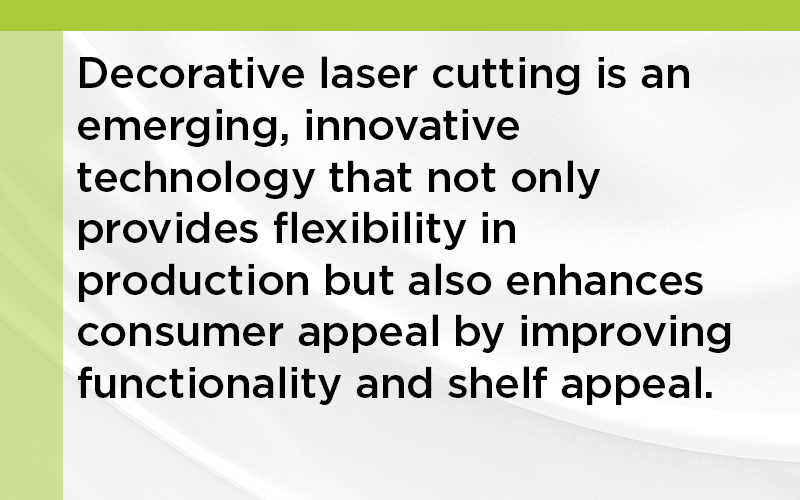
Decorative laser cutting is an emerging, innovative technology that not only provides flexibility in production but also enhances consumer appeal by improving functionality and shelf appeal. Decreased costs and better availability of laser cutting equipment have helped make the process a more feasible option for the print finisher to consider.
InsideFinishing consulted with industry experts at LasX Industries, Inc. to learn more about laser cutting technology and how it can potentially become part of a finisher’s offering.
Question: Has there been an increase in demand for laser cutting in recent years? What types of applications have seen the most growth?
Answer: Curiosity and interest in laser cutting have increased demand in recent years. Laser cutting can be used for a wide range of functional and creative print applications, including greeting cards, promotional materials, business cards, direct mail pieces, point-of-purchase signs, stencils and much more. The applications that have seen the greatest growth include product packaging, folding cartons and labels. These markets have benefited from the digital flexibility of producing only what is needed when it is needed, with no minimum run quantities.
Question: What type of room is needed for laser cutting equipment? Are there any special installation or ventilation considerations when installing a laser cutter?
Answer: Laser cutting systems vary in size but, generally, a basic stand-alone sheet-fed system requires an approximate 5×5′ area. Space can be saved on the manufacturing floor by integrating a laser module into an existing production line. In terms of installation requirements, fume exhaust and a water chiller/heat exchanger are necessary to keep the laser at a consistent temperature during processing. Look for laser systems that are certified as Class 1, which provide the highest level of safety during normal operation.
Question: What type of learning curve is involved for an operator of laser cutting equipment?
Answer: High-quality laser systems are designed to be user-friendly. The learning curve for a laser operator is approximately one week for those who have prior computer skills and a familiarity with a Windows operating system. Some manufacturers provide training to help familiarize new customers with laser technology and operating procedures.
Question: Is a laser cutter designed for decorating applications only or are there functional uses for laser cutting? For detailed work that may be able to be diecut, are there times when laser cutting may be a better option?
Answer: Although lasers excel at producing complex patterns and shapes, laser cutting is not reserved solely for decorative applications. In some cases, even if a pattern can be cut with a metal die, it still may be more cost- or time-efficient to use laser cutting. Examples of these circumstances include personalized or short-run jobs. In these cases, often the costs and lead times associated with creating a new die would be impractical or would lengthen critical timelines. Laser cutting may be a better alternative because of its ability to modify designs instantly on the production floor – there is no waiting for new dies to be created and no extra costs to create metal tooling.
So, even though the actual production time on-press may be longer on the laser cutter versus a conventional diecutting press, total in-house time may be less with laser cutting because there is no wait time for tooling. Additionally, laser technology allows for multiple processes in a single run, including laser cutting, perforating, etching and scoring. This offers production flexibility and efficiency by combining several finishing steps.
Question: What recommendations should be offered to a print finisher thinking of adding laser cutting as a new service?
Answer: Print finishers should consider the ways in which their business would benefit from providing laser cutting services. Not only does laser cutting offer expanded design features and the ability to create more complex, sophisticated patterns, but laser cutting also creates opportunities to enter new markets. In addition, no matter the application, laser processing makes low-volume production runs cost-efficient because die creation, tool wear and consumables are eliminated. On-demand, order-of-one laser processing decreases machine set-up, downtime and material waste, all of which stands to benefit print finishers.
There are a wide variety of laser cutting systems and configurations to choose from, depending on the needs. For example, LasX offers a range of sheet- and roll-fed laser systems, such as the LaserSharp® STP, a sheet-fed CO2 laser system that is ideal for print applications. Options such as barcode readers, vision cameras and automated material handling systems can be added to a laser system for increased productivity, or a laser module can be integrated directly inline with existing equipment as well.
InsideFinishing would like to thank LasX Industries, Inc. for its assistance with this article. LasX offers high-performance digital converting equipment and contract services using patented LaserSharp® technology. LasX delivers on-demand laser processing solutions that accurately cut, score, perforate, etch, weld or ablate components at high production rates. For more information, visit www.lasx.com.

